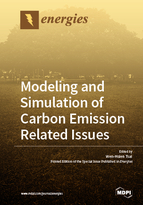Modeling and Simulation of Carbon Emission Related Issues
A special issue of Energies (ISSN 1996-1073). This special issue belongs to the section "A: Sustainable Energy".
Deadline for manuscript submissions: closed (30 November 2018) | Viewed by 91009
Special Issue Editor
Interests: sustainability; green production decision model; industry 4.0; corporate social responsibility (CSR); activity-based costing (ABC); enterprise resource planning (ERP); carbon emission cost; energy saving and carbon emission reduction; international financial reporting standards (IFRS)
Special Issues, Collections and Topics in MDPI journals
Special Issue Information
Dear Colleagues,
Baroness Anelay, former UK Minister of State of the Foreign and Commonwealth Office, said: “The threat of climate change needs to be assessed in the same comprehensive way as nuclear weapons proliferation.” In addition, both former Vice-President Al Gore and former President Barack Obama of United States deemed that climate change was a more dangerous threat to the world than international terrorism. The Paris Agreement was signed by 195 nations in December 2015 to strengthen the global response to the threat of climate change, following the 1992 United Nations Framework Convention on Climate Change (UNFCC) and the 1997 Kyoto Protocol. In Article 2 of the Paris Agreement, the increase in the global average temperature is anticipated to be held to well below 2 °C above pre-industrial levels, and efforts are being employed to limit the temperature increase to 1.5 °C above pre-industrial levels.
Global warning, also known as climate change, is mainly caused by several greenhouse gases, such as carbon dioxide (CO2), methane, nitrous oxide, and ozone, emitted by human activities in variety of ways, according to the Intergovernmental Panel on Climate Change (IPCC) Fifth Assessment Report in 2013. It is estimated that about 72% of the totally emitted greenhouse gases is carbon dioxide (CO2), 18% Methane and 9% Nitrous oxide. Therefore, carbon dioxide (CO2) emission (or carbon emission) is the most important cause of global warming. The vast majority of anthropogenic carbon emissions come from combustion of fossil fuels, principally coal, oil, and natural gas, with additional contributions coming from deforestation, changes in land use, soil erosion, and agriculture. United Nations had made possible efforts on greenhouse gas emissions mitigation. In Article 6 of the Paris Agreement, three cooperative approaches were presented that countries can take in attaining the goal of their carbon emission reduction, including direct bilateral cooperation, new sustainable development mechanism, and non-market-based approaches.
For the carbon emission reduction, several related issues and practical technologies were proposed, such as carbon footprint, carbon tax, cap and trade, carbon right purchasing, carbon emission cost analysis, internal carbon pricing, and so on. Cap and trade is one method for regulating and ultimately reducing the amount of carbon emission. The government sets a cap on carbon emission, limiting the amount of carbon dioxide that companies are allowed to release. Companies that can more efficiently reduce carbon emission can sell any extra permits in the emission market. Thus, the carbon trading markets were set up. Currently there are five trading in carbon allowances: the European Climate Exchange, NASDAQ OMX Commodities Europe, PowerNext, Commodity Exchange Bratislava and the European Energy Exchange.
In view of the urgent need for carbon emission reduction, we would like to invite researchers and professionals from universities, enterprises, and governmental units to share new ideas, innovations, trend, and experiences concerning the related issues of carbon emission, mentioned above and based on system modeling and simulation. The present special issue invites contributions on the following topics but not limit to: direct/indirect carbon emission, carbon emission in various industries, carbon emission in logistics, zero emission vehicle/plant/building, carbon emission reduction technologies, carbon footprint, carbon tax, cap and trade, carbon emission trading, carbon trading market, EU Emissions Trading System (EU ETS), carbon right purchasing, carbon emission cost analysis, internal carbon pricing, and enterprise carbon accounting. We welcome both original research articles, as well as review articles.
Prof. Dr. Wen-Hsien Tsai
Guest Editor
Manuscript Submission Information
Manuscripts should be submitted online at www.mdpi.com by registering and logging in to this website. Once you are registered, click here to go to the submission form. Manuscripts can be submitted until the deadline. All submissions that pass pre-check are peer-reviewed. Accepted papers will be published continuously in the journal (as soon as accepted) and will be listed together on the special issue website. Research articles, review articles as well as short communications are invited. For planned papers, a title and short abstract (about 100 words) can be sent to the Editorial Office for announcement on this website.
Submitted manuscripts should not have been published previously, nor be under consideration for publication elsewhere (except conference proceedings papers). All manuscripts are thoroughly refereed through a single-blind peer-review process. A guide for authors and other relevant information for submission of manuscripts is available on the Instructions for Authors page. Energies is an international peer-reviewed open access semimonthly journal published by MDPI.
Please visit the Instructions for Authors page before submitting a manuscript. The Article Processing Charge (APC) for publication in this open access journal is 2600 CHF (Swiss Francs). Submitted papers should be well formatted and use good English. Authors may use MDPI's English editing service prior to publication or during author revisions.
Keywords
- direct carbon emission
- indirect carbon emission
- carbon emission in various industries
- carbon emission in logistics
- zero emission vehicle
- zero emission plant
- zero emission building
- carbon emission reduction technologies
- carbon footprint
- carbon tax
- cap and trade
- carbon emission trading
- carbon trading market
- EU Emissions Trading System (EU ETS)
- carbon right purchasing
- carbon emission cost analysis
- internal carbon pricing
- carbon emission modelling
- carbon emission simulation
- enterprise carbon accounting






